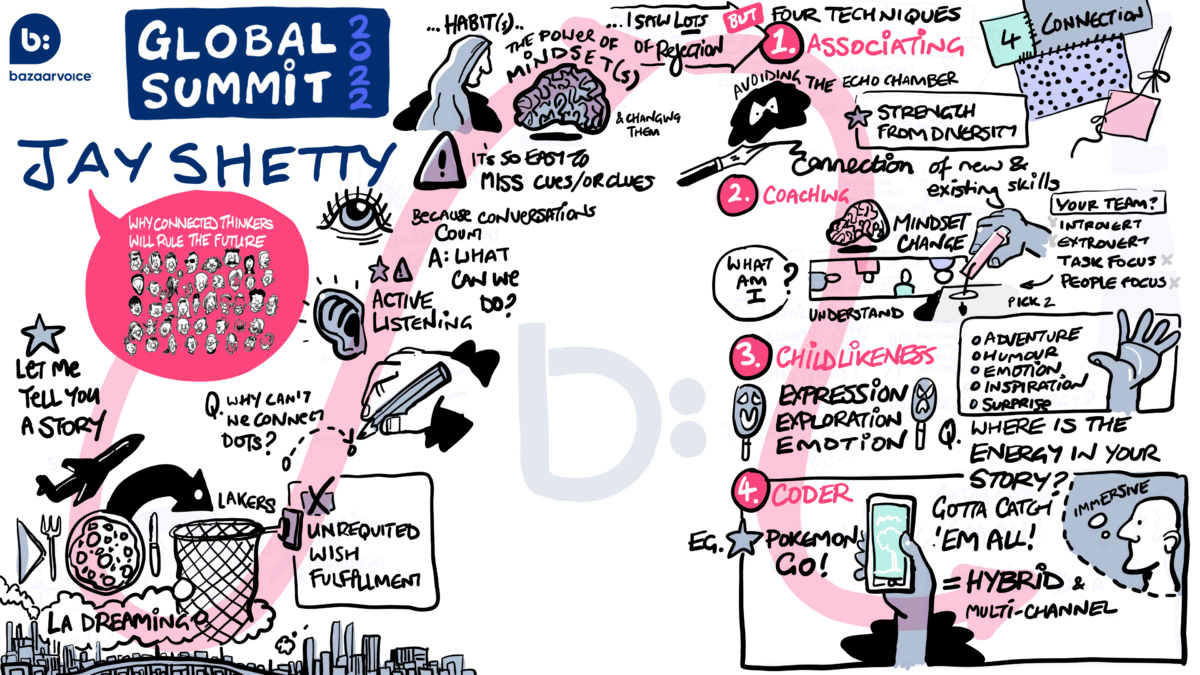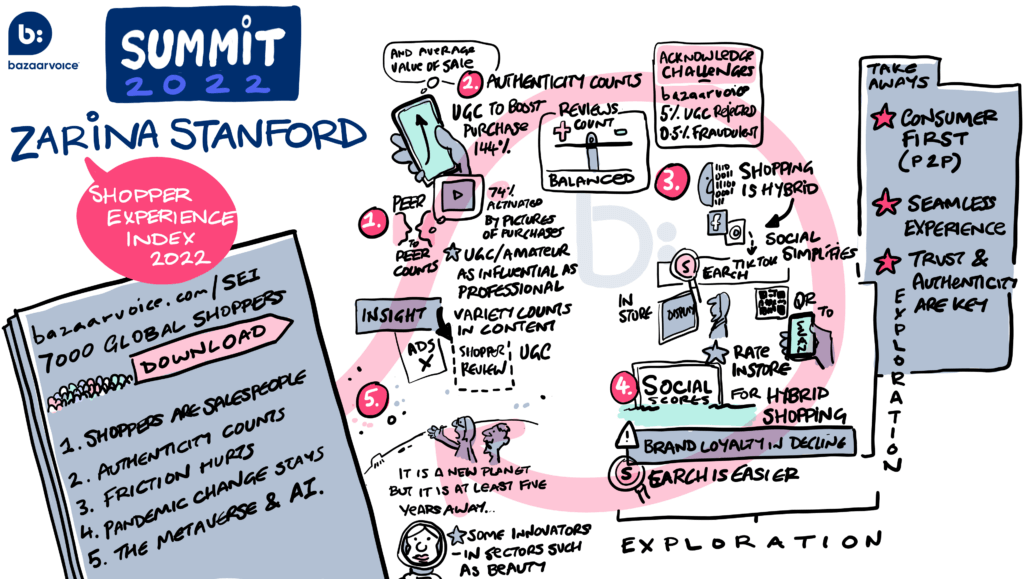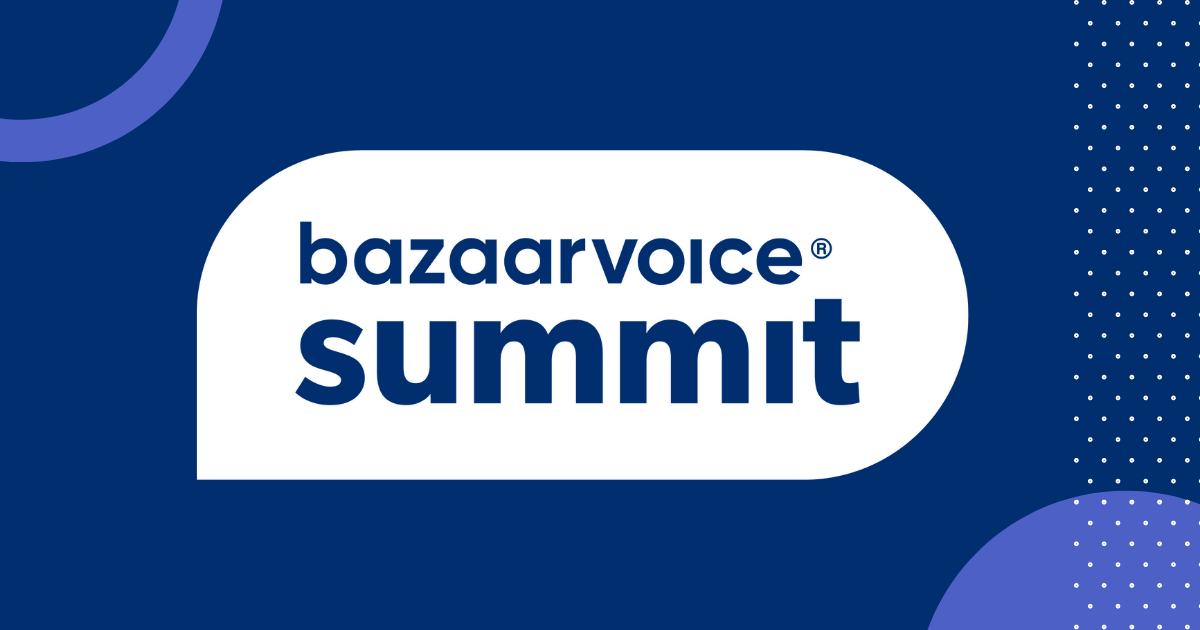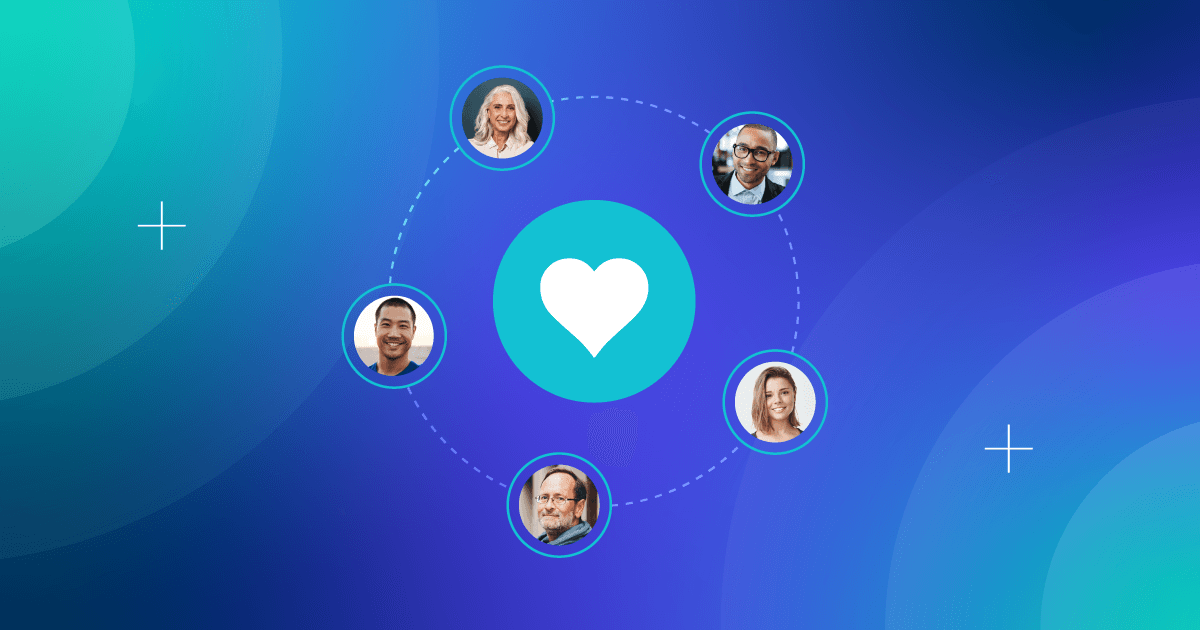April 7, 2022
These are live-blogged notes and sketches from a Bazaarvoice Summit keynote delivered by Jay Shetty, #1 NY Times Bestselling Author, podcaster, and former monk, on 6th April 2022. The rest of our Summit content can be found here.
When Shetty first travelled to LA from New York, he tweeted “I really hope that I can get a reservation at my favorite pizza place”. And then he tweeted about looking forward to exploring the area and tagged in the tourist board. And so he carried on, tweeting about getting tickets for the LA Lakers. Off he went to board his flight.
On the other end of the trip across the country, he made his way to his hotel. The concierge hurried over, told him that he’d spotted his tweets, made a reservation for him, and got him tickets for the LA Lakers game.
Great, huh?
Except, well, this didn’t actually happen. It could have happened. Maybe it should have happened. But it’s actually a remix of a story he heard from Marc Benioff. We live in a world where any number of people could have seen that tweet — but everyone missed it. Why? Because we’re not connected thinkers.
What is a connected thinker?
Connected thinkers find patterns where others see anomalies. We’re living in a time when big shifts are happening in the marketplace. Consumers hold the power, so they determine a brand’s perception. Perception is much more about community, authenticity, and trust. Imagine if a brand had really noticed those tweets — that brand would’ve been a hero, and it would’ve started a remarkable conversation.
Brands that start a conversation, build community, build customers and eventually build amazing commerce.
What conversations are you taking part in? People want to discover, share and shop every day. Are you part of that? Are you starting that? Or are you just letting those conversation go by? It’s so easy to miss these conversations, when we forget that we should be listening, hearing, and understanding — that’s how we build beautiful brands and businesses.
The four mindsets of the digital thinker
You need four mindsets to be a connected thinker. You don’t need to wait for the job title to come along, or have to reach a senior position. Anyone in an organization can adopt these mindsets. Shetty applied these mindsets even as an analyst early in his career. In 2013, he was applying to corporate jobs, after three years as a monk. He was living in his parents’ loft…
He was rejected by 40 companies before he got an interview. Turns out, no-one wants to hire a former monk. What are the transferable skills? Sitting quietly in silence? When he finally managed to get a job as an analyst, he was so grateful that he made the most of it by holding on to these four mindsets.
Where did connected thinking come from?
Harvard did a study on thousands of executives, and asked them to rank their top skills in order. The study found the skill that the majority of people considered most valuable was associating — aka the ability to connect ideas that other people wouldn’t be able to do.
Mindset #1: community thinking
MIT did a study on employee’s Twitter networks. One employee had a network that all knew each other. Another knew numerous people who didn’t know each other. The latter employee was the the more innovative, creative and impactful. His network didn’t live within an echo chamber. That has a massive professional impact. With a diverse network, you’re exposed to new cultures, new ways of life, new thinking.
Think about the five people you spend the most time with. How different are they in their life experience, their choices? As the saying goes, we become the average of the five people we’re closest to. If we get feedback from a wide spectrum of individuals, we get more quality, and more detailed, insight.
Steve Jobs once advised Mark Zuckerberg to go and spend time in a monastery, and it was there that he had the insight that his business was fundamentally about connecting people together. Interesting, isn’t it, that he had to go back to a traditional way of life for insight about the modern world? Jobs did that too, thinking about how he could bring calligraphy and engineering together in his products. Creativity is just connecting things.
Are you connecting yourself to new industries and new ways of thinking, but also old books and old ideas? It’s so powerful when we diversify the range of people that we connect with.
Mindset #2: Coach thinking
We all want our bosses and CEOs to be incredible coaches, but we too can be great coaches, within our teams.
Here’s a question to ask yourself: Are you outgoing or reserved? Are you people-orientated or task-oriented?
There’s four options here:
1) Outgoing, task-orientated
You’re a driver, a doer, who loves schedules and plans. If you’re to be a connected thinker, you need to remember that the people you’re talking with has a language and an agenda that is not yours. You want to get going, you want to get it done. You’re one of the people who can make others cry, because this is the mark of a high stress, high-pressure type.
2) Outgoing, people-orientated
These are the inspirers, the influencers, the negotiators, persuaders. These people talk a lot. But we need them to inspire us
3) Reserved, task-oriented
These people are calculative, cautious, quality-orientated, detail-oriented: these are the people who send you emails correcting your spelling mistakes. These people are focused on making things work, on quality.
4) Reserved, people-oriented
These people are loving, stable, supportive and highly emotionally intelligent. These are the people you go to for a hug.
When you’re a connected thinker, you need to realize that different people in the team think differently, and that’s not wrong. It’s just different. Consumers, too, will be broadly in these four categories. How can we use their language, their psychology to help us communicate to them better?
Einstein said that everyone is a genus, but if you judge a fish by its ability to climb a tree, it will always think it’s stupid. We all think based on our wiring, and acknowledging that makes you an effective coach.
Mindset #3: Child-like thinking
In order to be innovative, to think in a connected way, we need that sense of childishness. Children have a sense of authenticity and innocence. People want to connect with brands that have that authenticity, have that child-like curiosity, and are developing and growing.
Studies show that viral articles tend to have one of a handful of themes:
- Adventure
- Humor
- Emotion
- Inspiration
- Surprise
All of these are about expression. They’re not educational, they’re things that make you feel something. What do people feel when they interact with your brand. What’s the energy that they come across?
We all know the energy of a child. If we don’t give ourselves space to think authentically, to play, we hamper our own creativity.
Mindset #4: Coder thinking
Have you played Pokémon Go? If you haven’t, you’re missing out. The founder created this augmented reality experience, because he used to go out and explore nature with his father. He wanted to encourage people to go outdoors just like he did, even if they’re always on their phones.
Coders are able to realize that the physical and digital world are one. The omnichannel experience is so critical right now — people are looking for merged experiences, they don’t want to think about “online” or “offline”, but both.
Businesses that don’t embrace this way will struggle. People are looking for 360 degree experiences. What will we miss out on if we don’t think about that?
Making this work for you
So, how to you bring connected thinking into your work and become a connected thinker? Here’s some practical suggestions.
Community thinking: Once a week, bring in someone unique, interesting, or different, to sit in on your meetings and see how they respond to it. Younger people, older people, people from different geographies or experiences. You’ll learn so much more than any focus group can give you.
Coach thinking: Consider the strengths of every single person on your team. Sit down and list them by their category, and do the same for your ideal customer.
Child-like thinking: Observe your children, or your nieces or nephews, or children around you. They think washing machines are spaceships or time machines, and a mirror is a portal to another world. Watch how people interact with your product. Even the way they hold it can give you new inspiration.
Coder-thinking: Stop seeing the limitations between physical and digital, and merge the worlds. We’re always holding a digital device at every moment.
And then take these mindsets and apply them to your personal life, too.
The retail industry is as strong as ever. And consumers hold the power like never before. They decide how a brand is perceived, and the risk of boycott in today’s cancel culture is very real. The dramatic power shift to customers has led to heightened actions and vocalizing for authenticity, improved experiences, and above all, for consumers to feel heard. Catch up on Bazaarvoice Summit to see how to win hearts and minds of today’s consumers.









